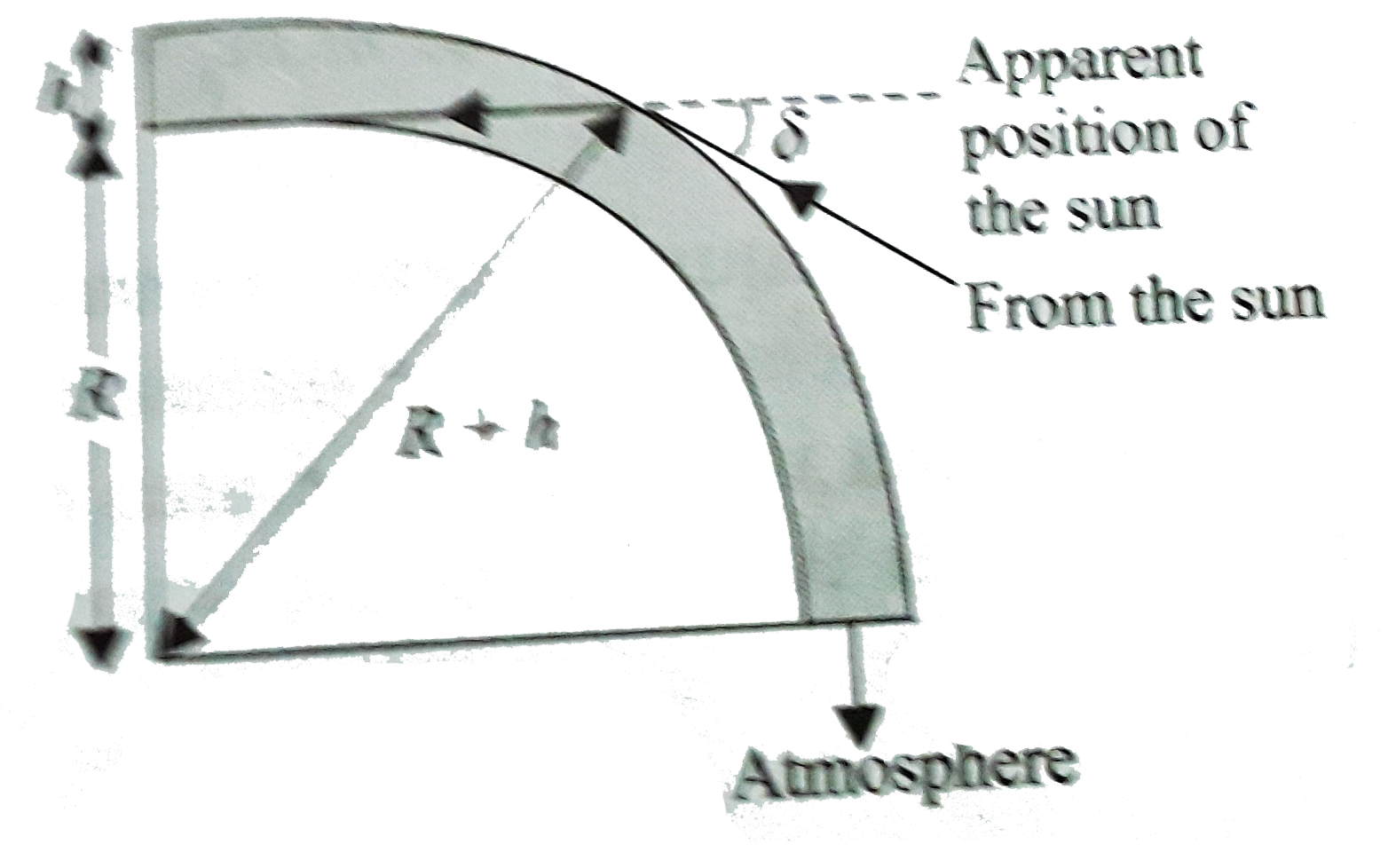When the sun appears to be just on horizon, it is in fact below the horizon. This is because the light from the sun bends when it enters the earth’s atmosphere. Let us assume that atmosphere is uniform and has index of refraction equal to μ. It extends upto a height h(<<R= radius of earth) above the earth’s surface. In absence of atmosphere how late would we see the sunrise compared to what we see now? Take time period of rotation of earth to be T. Calculate this time for following data
R=6400km,μ=1.0003,h=20km,T=24hr.
The correct Answer is:Δt=T2π[sin−1(μRR+h)−sin−1(RR+h)]=0.9 minute.
Step by step video, text & image solution for When the sun appears to be just on horizon, it is in fact below the horizon. This is because the light from the sun bends when it enters the earth’s atmosphere. Let us assume that atmosphere is uniform and has index of refraction equal to mu. It extends upto a height h (lt lt R = radius of earth) above the earth’s surface. In absence of atmosphere how late would we see the sunrise compared to what we see now? Take time period of rotation of earth to be T. Calculate this time for following data R = 6400km, mu = 1.0003, h = 20 km, T = 24hr. by Physics experts to help you in doubts & scoring excellent marks in Class 12 exams.
Updated on:21/07/2023Topper's Solved these Questions
- GEOMETRICAL OPTICSBook:ARIHANTChapter:GEOMETRICAL OPTICSExercise:Level 3
Explore 9 Videos
- GEOMETRICAL OPTICSBook:ARIHANTChapter:GEOMETRICAL OPTICSExercise:Level 3
Explore 9 Videos
- ELECTROSTATICSBook:ARIHANTChapter:ELECTROSTATICSExercise:Level 3
Explore 59 Videos
- MAGNETIC EFFECT OF CURRENTBook:ARIHANTChapter:MAGNETIC EFFECT OF CURRENTExercise:Magnetic effect of Current
Explore 45 Videos
Similar Questions
Knowledge Check
When the sun is either rising or setting and appears to be just in the horizon, it is in fact below the horizon. The explanation for this seeming paradox is that light from the sun bends slightly when entering the earth's atmosphere as shown in figure. Assume that the atmosphere has uniform density and hence uniform index of refraction n and extends to a height h above the earth's surface, at which point is abruptly stop. The angle δ above the Sun's true position is given by
 Asin−1(nRR+h)Bsin−1(RR+h)Csin−1(nRR+h)+sin−1(RR+h)Dsin−1(nRR+h)−sin−1(RR+h)
Asin−1(nRR+h)Bsin−1(RR+h)Csin−1(nRR+h)+sin−1(RR+h)Dsin−1(nRR+h)−sin−1(RR+h)The earth binds the atmosphere because of
AGravityBOxygen between earth and atrnosphereCBoth (a) and (b)DNoneWe can see the Sun even when it is little below the horizon because of
AReflection of lightBRefraction of lightCDispersion of lightDAbsorption of light
The height from the surface of earth and electron density of D layer of earth's atmosphere are
View SolutionWe can see the Sun even when it is little below the horizon because of
View SolutionThe layer of atmosphere that is just above the earth's surface is called ______.
View SolutionQuestion Stimulus
What is the main cause of movement in the earth’s atmosphere?
View SolutionIf there was no carbon dioxide in the Earth's atmosphere, the temperature of Earth's surface would be :
View Solution

